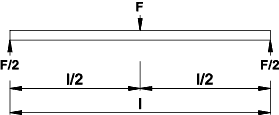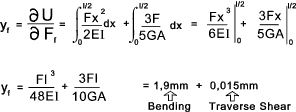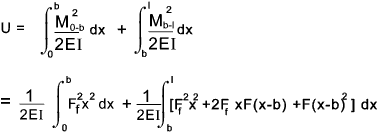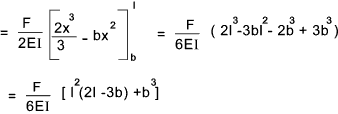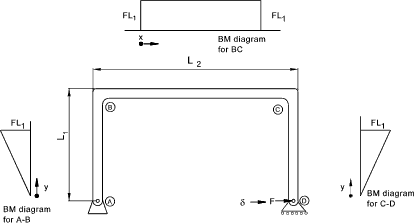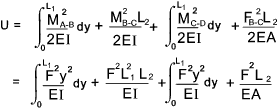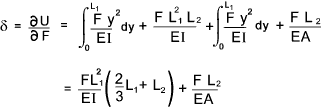Castigliano's Method
|
Introduction When external forces are applied to an beam or structure the structure distorts. The external forces perform work and the energy is stored in the structure in the form stress and elastic deformation. In conformance with the law of conservation of energy the work done in the small movements of the external forces (W) must be equal to the potential energy U stored in the structure. External Work Done = Internal Energy Stored When the external forces are removed the beam or structure rebounds elastically, and the stored
potential energy returns to zero..... This method provides a means of finding a particular deformation at a particular point.
Unlike the method of double integration, it does
not provide general equations for linear and angular deformations for every point
on a beam or structure. For may problems a particular solution is often the
only information required and the energy method is the most convenient option When forces act on elastic systems subject to small displacements, the displacement corresponding to any force
collinear with the force is equal of the partial derivative to the total strain energy with respect to that force. Mathematically Catigliano's theorem is stated as follows..
δ i is the displacement of the point of application of the force F i in the direction of F i..
θ i is the rotational displacement (radians) of the moment M i in the direction of M i .. The procedure to be applied in using Castiglianos's theorem is as follows
a) To determine an angular deflection θ f in
the direction of a real or fictitious moment M f
Some examples of the use of Castigliano's theorem are provided to illustrate the principles.. Example 1
Consider a simply supported beam with a central load F. The deflection at the central load point is to
be determined.
For this example it is assumed that the beam is a rectangle width b and depth h.
The strain energy for bending and for traverse shear is included in the consideration.
Because the beam is symmetrical the deflection at the central point is obtained by doubling the solution
from 0 to l/2. Moment M = (F/2).x and Tranverse Force V = F/2 With reference to the webpage on strain energy Strain Energy 1) The expression for the total strain energy =
2) From Castigiano's theorem the deflection of the Force F in the direction of F y f = ∂U /∂ F f
As can be seen from the above example the deflection resulting from the traverse shear is about
0,8% that of resulting from bending and is therefore generally ignored... Consider the cantilever beam with a load F at a distance b from the free end.
The deflection at the free end is required and so a fictitious load Ff has been added.
The strain energy due to traverse shear loading can be neglected.
1) With reference to the webpage on strain energy Strain Energy The equation for the strain energy is therefore..
2) From Castigiano's theorem the deflection of the Force Ff in
the direction of Ff y f = ∂U /∂ F f
3) Setting Ff to zero and integrating for x results in
Consider the frame as shown below with one leg free to move horizontally and the other leg pivotted.
A horizontal force F is applied to the free leg and the deflection of the free leg is
required. The strain energy due to traverse shear loading can be neglected.
The expression for the moment in CD M = Fy 1) With reference to the webpage on strain energy Strain Energy The equation for the strain energy is therefore..
2) From Castigiano's theorem the deflection of the Force F in the direction of F δ = ∂U /∂ F f
|
Links to Spring Design
|
|
Beams Index
